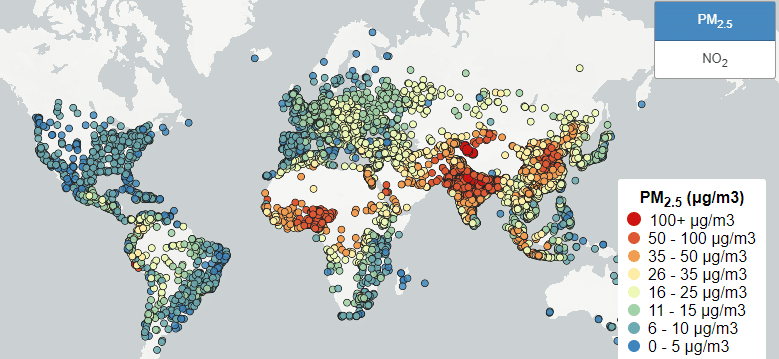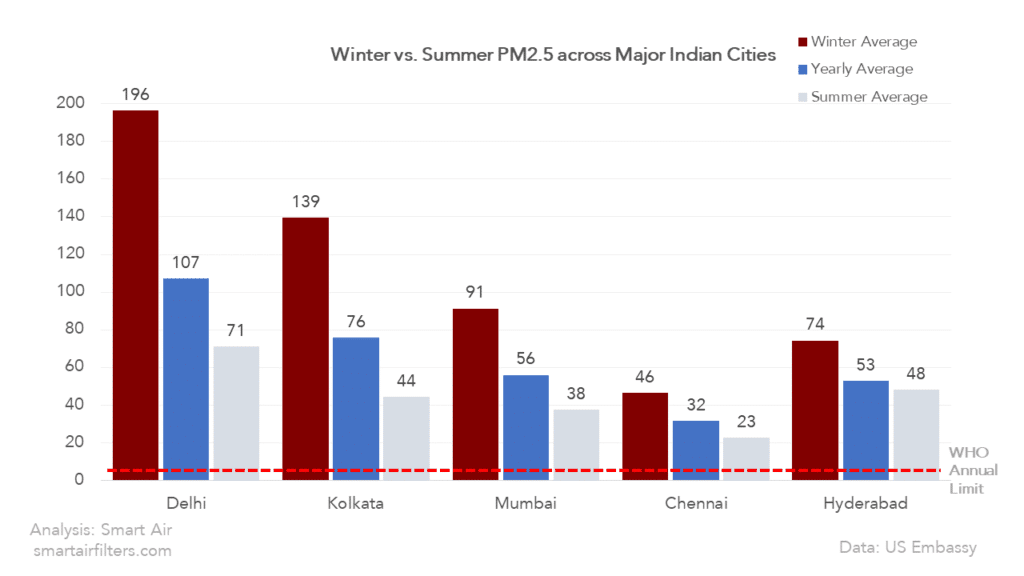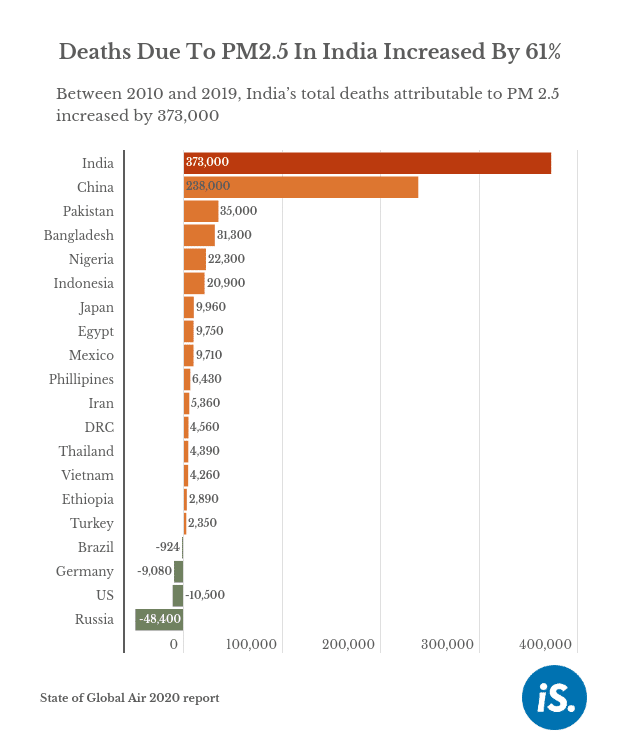Air Pollution in India – An Ongoing Crisis
Source: Wall Street Journal
22 August 2024 – by Eric Koons
Air pollution in India has a long history. In the 1970s and 1980s, the issue was relatively localised, primarily affecting industrial areas. However, since the 1990s, rapid urbanisation, industrialisation and a surge in vehicular traffic have exacerbated the problem. The situation has reached a critical point in the last decade, with direct economic losses amounting to 1.36% of its GDP in 2019 alone.
In 2015, the Indian government launched the National Air Quality Index for air quality monitoring.
What Is India’s Rank in Air Pollution?
India consistently ranks among the countries with the highest levels of air pollution globally. According to the World Air Quality Report 2023, India holds the dubious distinction of having 21 of the world’s 30 most polluted cities.
Delhi Air Pollution
Delhi, the capital, frequently sits near the top of the list with alarming levels of PM2.5 and PM10 pollutants.

For instance, in 2023, Delhi’s average annual PM2.5 concentration was 102.1 µg/m³, more than double the national safe limit and over 20 times the World Health Organisation’s recommended level of 5 µg/m³.
Over the years, India’s position has worsened, reflecting the growing severity of the country’s air quality crisis. Between 1998 and 2021, particulate matter pollution increased by over 67% and between 2013 and 2021, the country accounted for over 59% of the world’s increase in air pollution.
How Much Air Pollution is in India in 2024?
In 2024, outdoor air pollution levels in India remain critically high. Summer typically sees lower levels of air pollution across the country as agricultural burning happens during winter. However, recent data shows summer air pollution is rising faster than ever. In July 2024, only five of 250 cities had average air pollution levels below the WHO’s recommended levels.

What is the Main Cause of Air Pollution in India?
Air pollution in India stems from multiple sources, both anthropogenic and natural. However, the leading source is burning fossil fuels. The top contributors include industrial emissions, which account for about 50% of the air pollution, vehicular pollution at 27%, 17% from crop burning and 7% from domestic cooking.
While this is a nationwide average, the share of pollution varies by region. Urban areas are dominated by industry and vehicles, whereas rural areas see a higher contribution from agriculture.
Industrial Pollution and Vehicular Emissions
Industrial activities and vehicular emissions are the primary culprits of India’s air pollution. Factories and power plants in urban areas release large quantities of pollutants, including sulfur dioxide (SO2) and nitrogen oxides (NOx).
Meanwhile, the rapid increase in vehicles has led to higher carbon monoxide (CO) and particulate matter emissions. For example, there were 115 million registered vehicles in the country in 2010; as of 2023, this had jumped to 326 million. The vast majority of these are fossil fuel powered, with only 2.8 million electric vehicles on the road in 2023.
Agricultural Practices and Waste Burning
Agricultural practices, particularly stubble burning in states like Punjab and Haryana, contribute significantly to seasonal spikes in air pollution. During the post-harvest season, farmers burn 87 million tonnes of crop residue, releasing large amounts of PM2.5 and PM10 into the atmosphere.
This practice severely impacts air quality, especially in winter months. Additionally, the burning of waste, both urban and rural, adds to the pollution load.
Cooking and Indoor Air Pollution
Cooking is another significant contributor to air pollution in India, particularly in rural areas. The use of solid fuels like wood, cow dung and crop residues for cooking and heating results in high levels of indoor pollutants. More than 40% of Indian households still rely on these solid fuels, exposing the average Indian to air pollution 13 times greater indoors than outdoors.
What Are the Effects of Bad Air Quality in India?
The effects of air pollution impact public health, the environment and the economy. The health consequences are particularly dire, with air pollution linked to respiratory diseases, cardiovascular problems and premature deaths. Environmentally, pollution affects visibility, damages ecosystems and contributes to climate change. Economically, the costs are substantial, including healthcare expenses and lost productivity.
Health Impacts
Ambient air pollution is a leading cause of health issues in India. Statistics indicate that around 1.67 million deaths in 2019 were attributable to air pollution-related diseases. Furthermore, between 2008 and 2019, air pollution was linked to 33,000 deaths annually in just 10 cities.

Respiratory conditions, such as asthma, bronchitis and chronic obstructive pulmonary disease (COPD) are common, especially among vulnerable populations like children and the elderly. Cardiovascular diseases, including heart attacks and strokes, are also linked to long-term exposure to polluted air.
Environmental and Economic Impacts
The environmental impact of air pollution extends to wildlife and natural habitats, disrupting ecosystems and reducing biodiversity. This directly translates to the agricultural sector. For example, wheat yields declined around 14% between 2008 and 2012 due to air pollution from ground-level ozone.
Economically, the burden is significant. The economic cost of India’s air pollution is estimated at USD 95 billion, encompassing healthcare costs, reduced labour productivity and premature death. If air pollution had been brought below the WHO’s recommended levels, the country would have gained 1.4 billion working days in 2019, translating to an additional USD 6 billion in business revenue.
Addressing the Air Quality Crisis
The current state of air pollution in India demands immediate and sustained action and steps like the National Clean Air Programme. While the country has implemented numerous air quality regulations dating back to as early as 1905, they have been unable to keep up with rapid urbanisation and curb its air quality issues.
Reducing pollution levels will not only improve public health and the environment but also bring economic benefits. It is a critical component for the country’s continued rapid economic growth. Stronger policies, better enforcement of regulations and public awareness campaigns are essential to tackle the issue. Collective efforts from the government, industries and citizens are needed to help achieve cleaner air and a healthier future for India.
by Eric Koons
Eric is a passionate environmental advocate that believes renewable energy is a key piece in meeting the world’s growing energy demands. He received an environmental science degree from the University of California and has worked to promote environmentally and socially sustainable practices since. Eric’s expertise extends across the environmental field, yet he maintains a strong focus on renewable energy. His work has been featured by leading environmental organizations, such as World Resources Institute and Hitachi ABB Power Grids.
Read more




